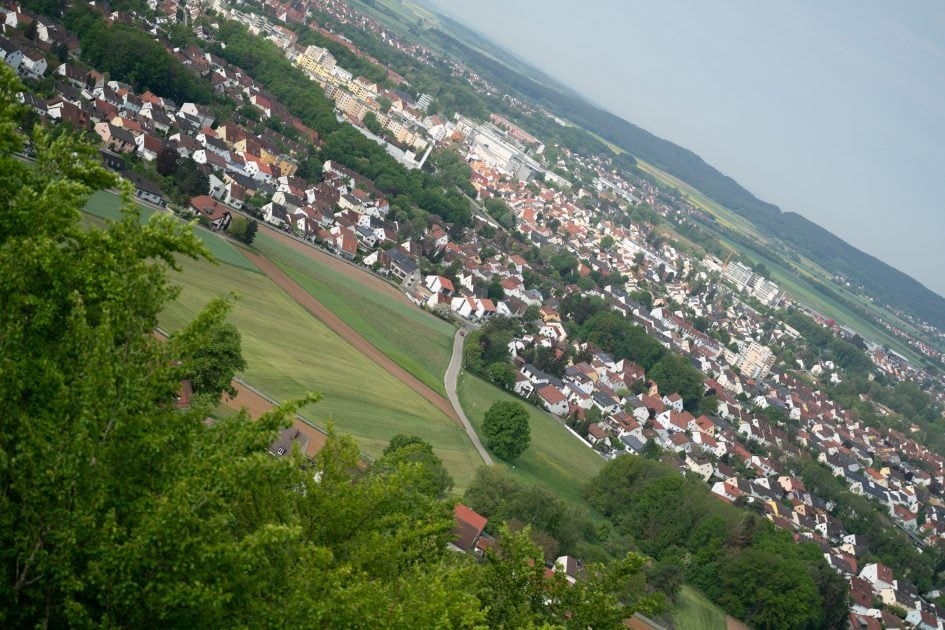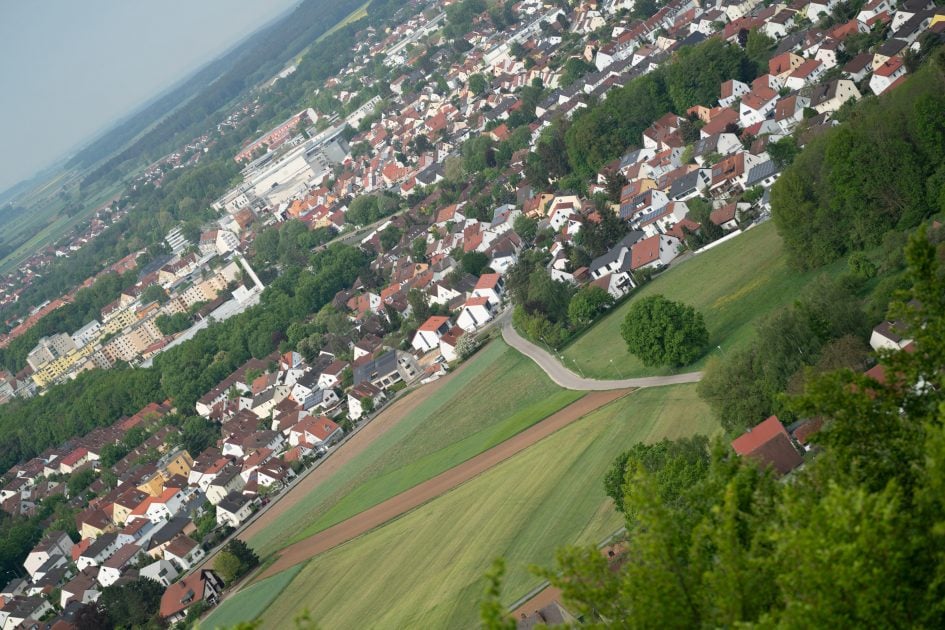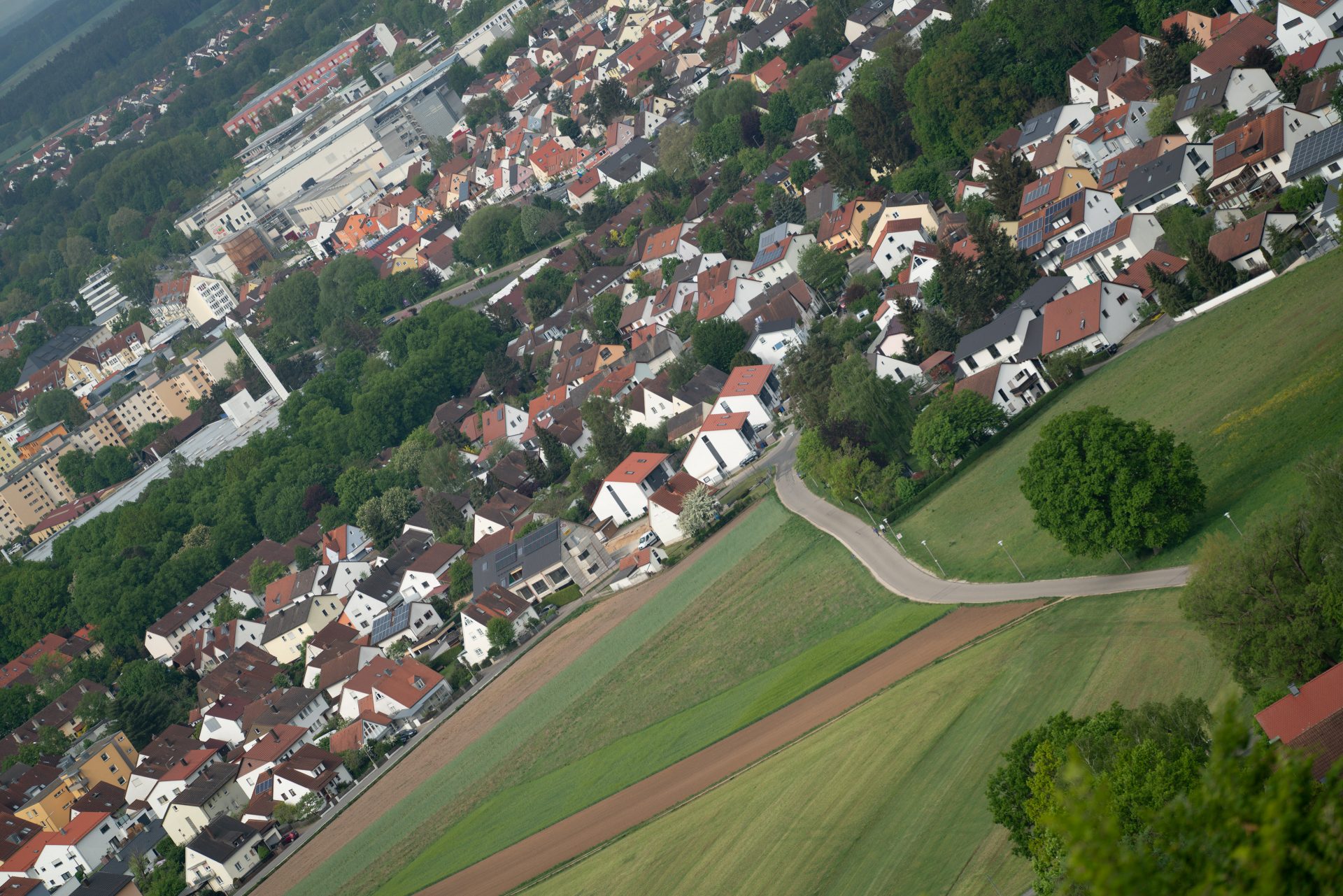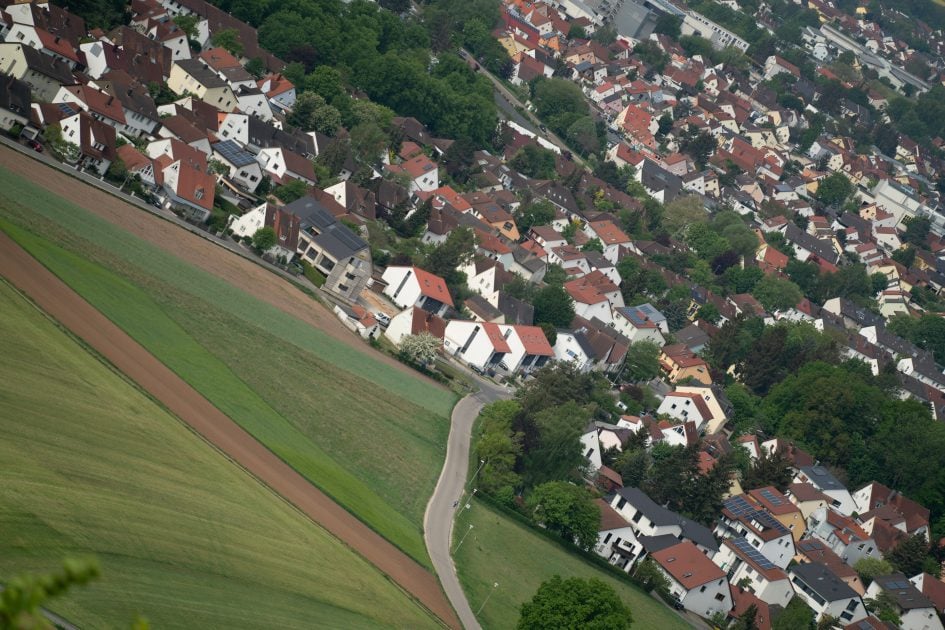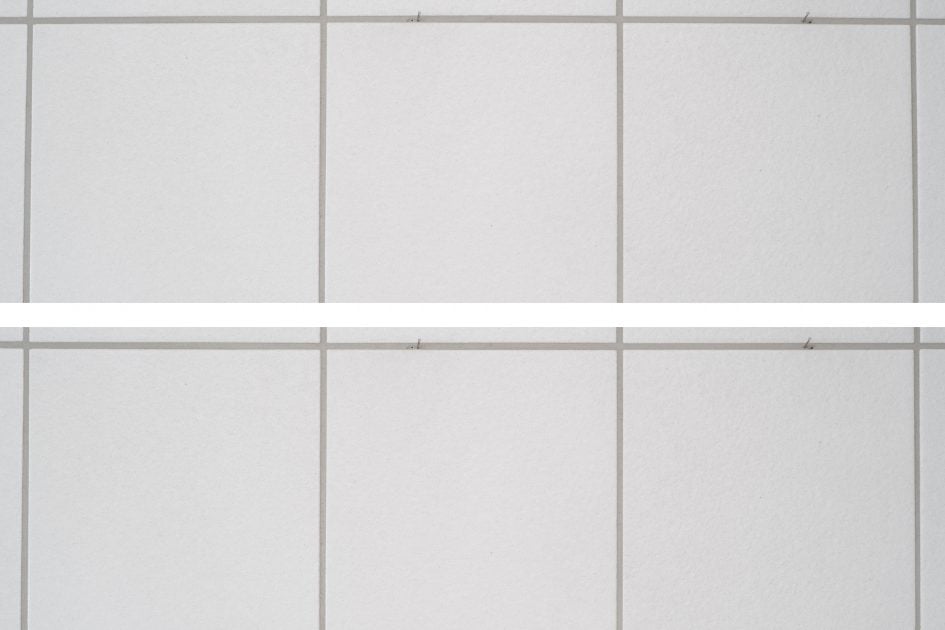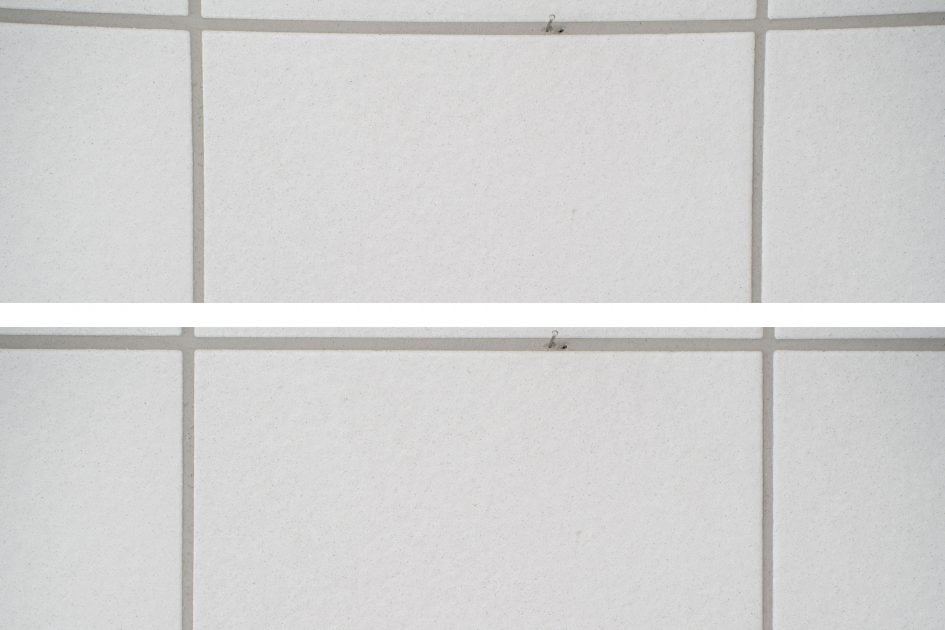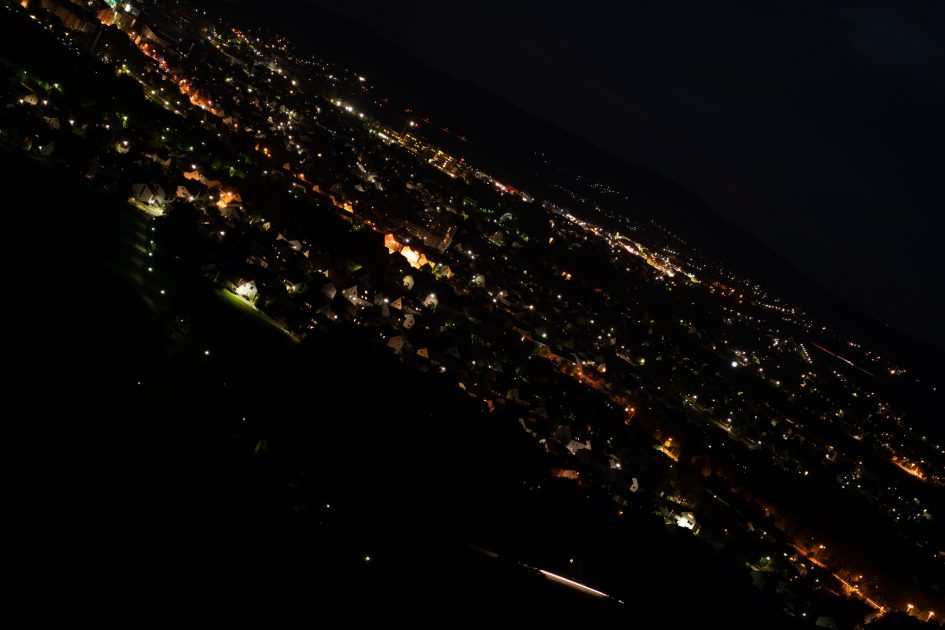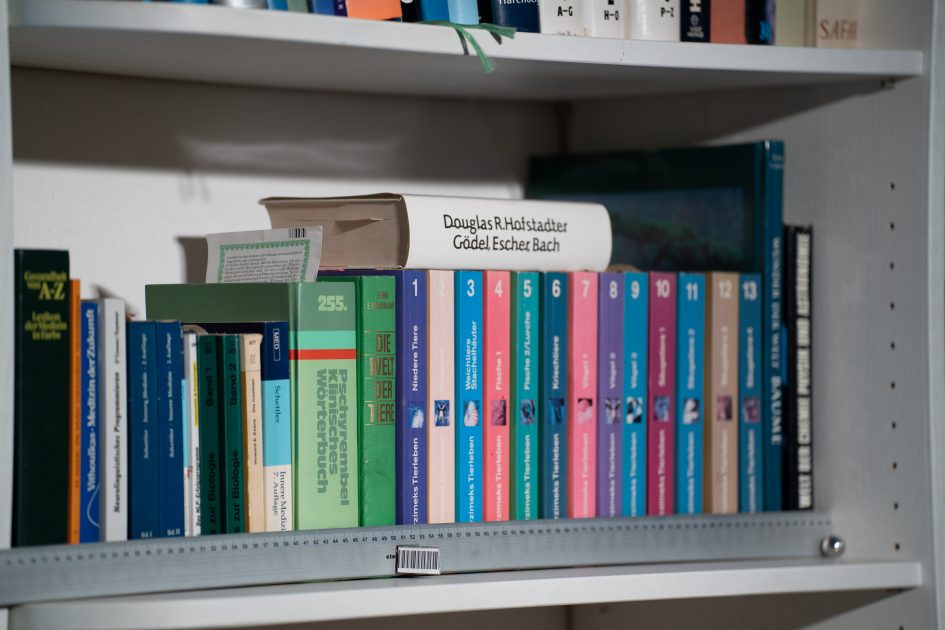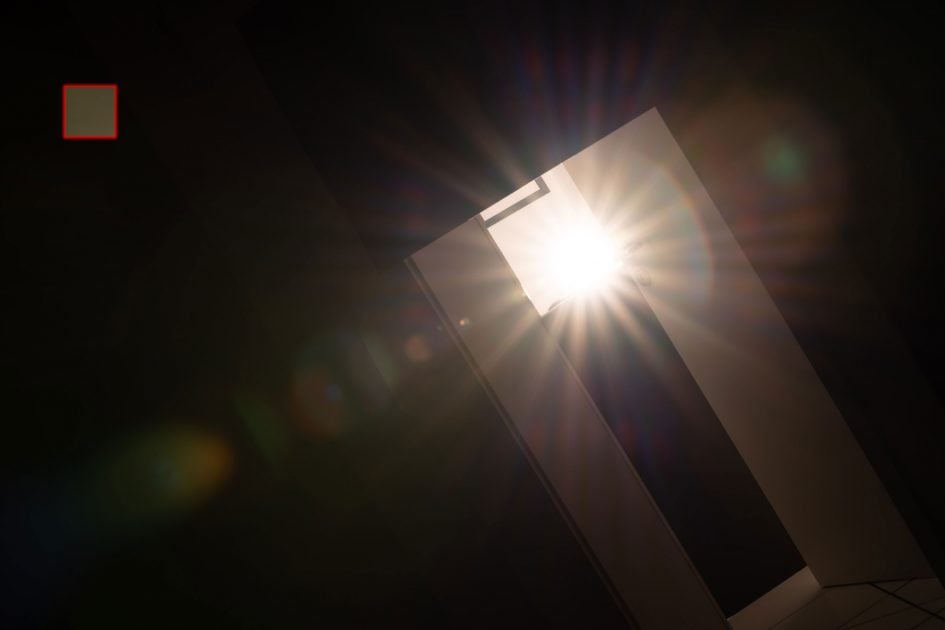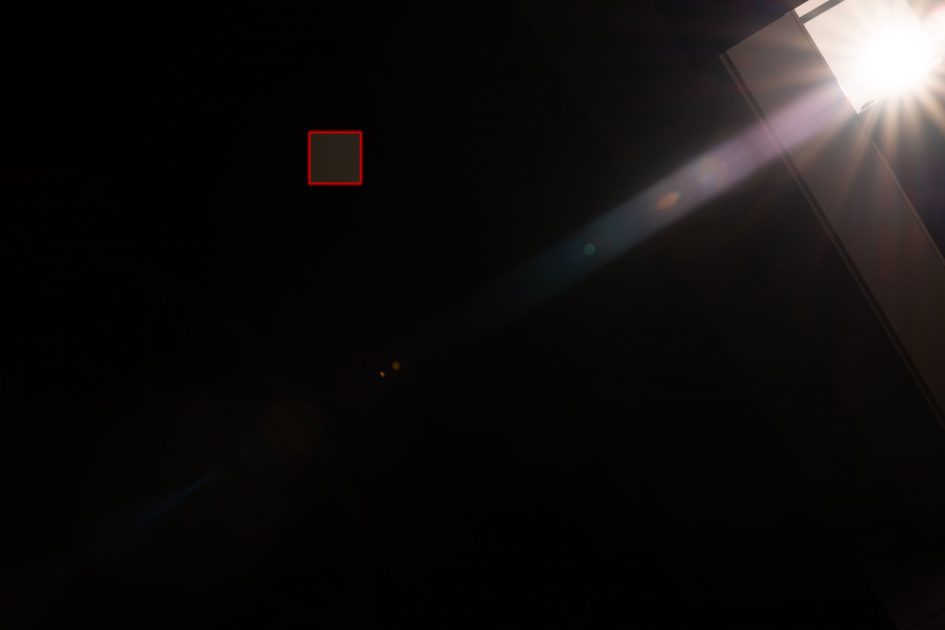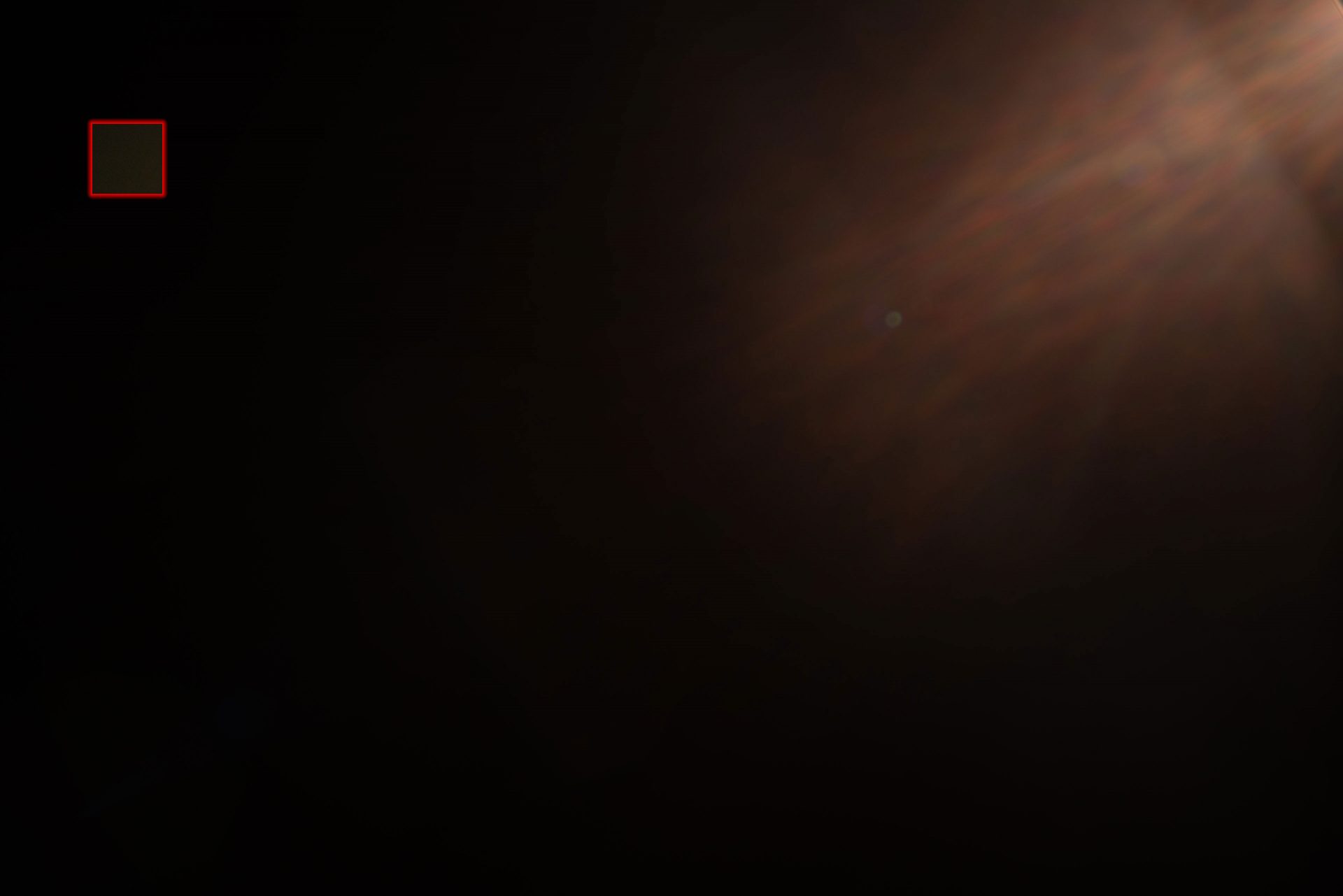Tamron 70-180mm f2.8 Di III VXD review
-
-
Written by Thomas
Quality
Testing: Longitudinal Chromatic Aberration and focus shift
Lenses with focal ratios of f2.8 or larger are often prone to longitudinal color aberrations (loCA, a.k.a. “axial color” or “bokeh CA”). These normally show up as magenta coloration in the foreground and greenish hues in the background and are not easily corrected in post-processing. The new Tamron has very little loCA.
Tamron 70-180mm f2.8 Di III Longitudinal Chromatic Aberration (loCA) at 180mm
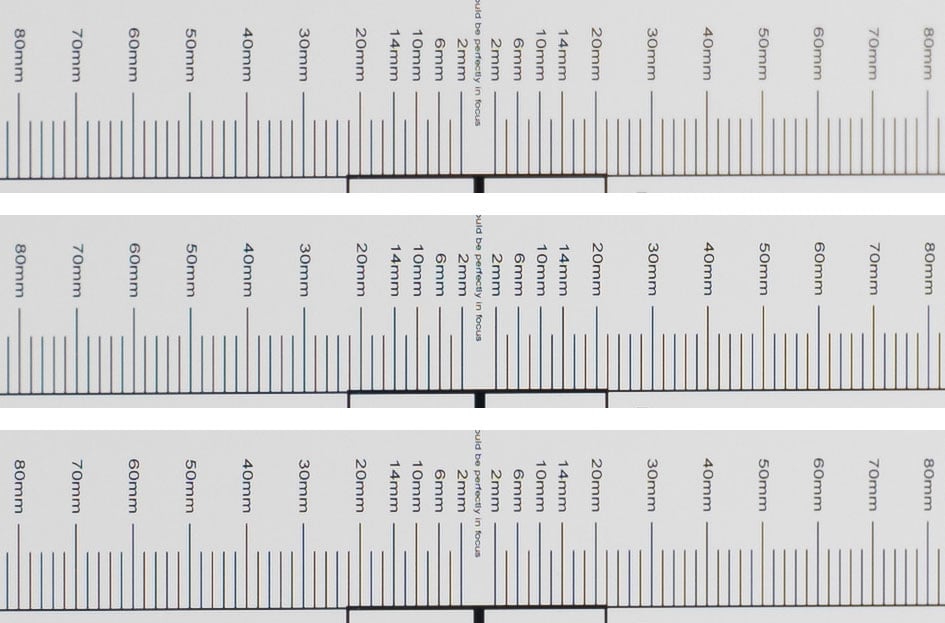
100% crops, from top to bottom: f2.8, f4.0, f5.6; left = foreground, right = background
Even specular highlights show only little coloration as you can see in the shot of a fountain on the next page. Very good! There’s also no focus shift to speak of. For comparison see the Sony FE 70-200mm f2.8 GM OSS here.
The following real life shot shows that the Tamron 70-180mm f2.8 Di III produces no purple fringing around high-contrast edges in the focal plane or green outlining around background subjects:
Above: Tamron 70-180mm f2.8 Di III at 70mm f2.8, 100% crop, click image for 4k version, here for large original
Above: Sony FE 70-200mm f2.8 GM OSS at 74mm f2.8, 100% crop, click image for 4k version, here for large original
The Sony FE 70-200mm f2.8 GM OSS in comparison produces a bit of magenta coloration around dark edges but much less glare than the Tamron. Both shots were exposed identically.
Sharpness and contrast
Let’s have a look at the theoretical performance of the new Tamron 70-180mm f2.8 Di III first and compare it to the performance of the Sony 70-200mm f2.8 GM OSS and two DSLR designs: the Tamron 70-200mm f2.8 VC G2 and the Sigma 70-200mm f2.8 OS Sports:
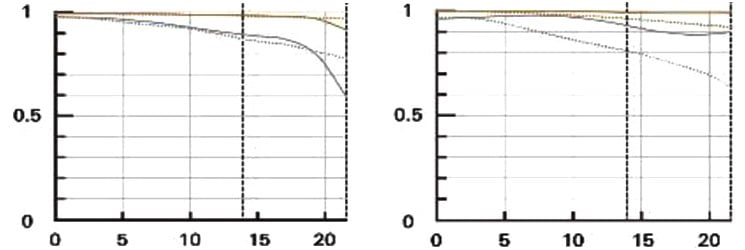
Above: MTF Tamron 70-180mm f2.8 Di III at 70mm f2.8 (left), 180mm f2.8 (right)
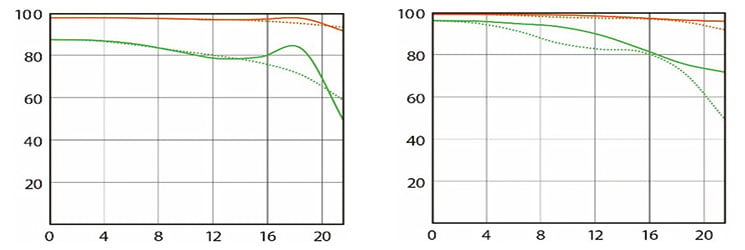
Above: MTF Sony 70-200mm f2.8 GM at 70mm f2.8 (left), 200mm f2.8 (right)

Above: MTF Tamron 70-200mm f2.8 VC G2 at 70mm f2.8 (left), 200mm f2.8 (right)
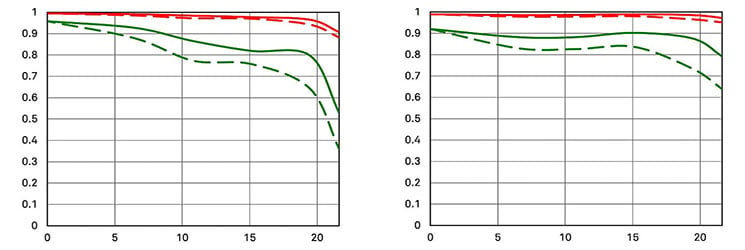
Above: MTF Sigma 70-200mm f2.8 OS Sports at 70mm f2.8 (left), 200mm f2.8 (right)
These MTF charts show the computed lens-performance of lenses wide open without influence of diffraction. Higher values are better (more contrast) and the closer the line-pairs are together the less astigmatism (= resolution depends on the orientation of the test-pattern) the lens has. The x-axis displays the distance from the optical axis (=center of the sensor) in mm. I’ll show you the real-life performance at 4 mm (center), 13 mm (APS-C-corner), and 20 mm (FF-corner) on a 42MP Sony A7R II camera.
From the charts the new Tamron 70-180mm f2.8 Di III should show better resolution than the Sony and the Sigma at the short end. At the long end the new Tamron also shows very good resolution – but only in the sagittal direction. The meridional contrast drops faster towards the corners due to astigmatism – but with resolution still at a level similar to the Sony. All-in-all this looks very promising for Tamron’s new 70-180mm f2.8 Di III.
Let’s see how this theoretical performance translates into real life results in the sharpness test based on Siemens-stars. Processing was done in Lightroom 9.2/CRAW 12.2 from RAW to Adobe Color profile with the built-in lens profile for shading and CA compensation applied. Noise-reduction is set to 0, sharpening to 50/0.5/36/10, with no extra tone, color, or saturation adjustment. White-balance was adjusted to a neutral white and I did some exposure compensation to make the brightness of all crops match. So you will not see light fall-off in the corners.
The following are all 100% crops!
First up is an overview of the wide-open performance at different focal lengths. You can jump to the detailed results at different apertures and comparisons with the competition by clicking on the crops of the respective focal length.
For those interested in how much of a loss the missing 20mm on the long end are I also included a digitally zoomed version which resembles shooting at 200mm focal length.
Tamron 70-180mm f2.8 Di III; 100% crop from center, APS-C-corner, FF-corner
Above: 70mm, f2.8
Above: 105mm, f2.8
Above:150mm, f2.8
Above: 180mm, f2.8
Above: 200mm, f2.8
Tamron’s new zoom lens is very sharp across the full-frame sensor throughout the zoom-range with just a slight softening in the FF-corner at 70mm and 180mm focal length. Electronically zooming to 200mm reduces acuity a bit – but we are pixel-peeping here. The lens also exhibits very little field curvature on the short end but at 150mm and 180mm focal length it is quite visible.
If you want to see all the details, read on. Or you can fast-forward to the performance at long distances.
The following 100% crops for each focal length show the new Tamron 70-180mm f2.8 Di III from f2.8 down to f11 compared to the Sony FE 70-200mm f2.8 GM OSS and Tamron 70-200mm f2.8 VC G2. The Tamron G2 was shot on a 35MP Nikon D810 which has a 7% lower linear resolution. But you can still get a good picture of how the Tamron G2 performs in comparison.
Performance at 70mm:
Tamron 70-180mm f2.8 Di III at 70mm; 100% crop from center, APS-C-corner, FF-corner

Above: Tamron 70-180mm f2.8 Di III at 70mm, f2.8

Above: Sony FE 70-200mm f2.8 GM OSS at 70mm, f2.8

Above: Tamron 70-200mm f2.8 VC G2 on a D810 at 70mm, f2.8

Above: Tamron 70-180mm f2.8 Di III at 70mm, f4.0

Above: Tamron 70-180mm f2.8 Di III at 70mm, f5.6

Above: Tamron 70-180mm f2.8 Di III at 70mm, f8.0

Above: Tamron 70-180mm f2.8 Di III at 70mm, f11
At 70mm focal length the new Tamron 70-180mm f2.8 Di III is sharper outside the center than the Sony which shows a pretty mushy FF-corner. The Tamron G2 is also pretty sharp including the FF-corner but suffers a bit from lower overall contrast.
Performance at 105mm:
Tamron 70-180mm f2.8 Di III at 105mm; 100% crop from center, APS-C-corner, FF-corner

Above: Tamron 70-180mm f2.8 Di III at 105mm, f2.8

Above: Sony FE 70-200mm f2.8 GM OSS at 105mm, f2.8

Above: Tamron 70-200mm f2.8 VC G2 on a D810 at 105mm, f2.8

Above: Tamron 70-180mm f2.8 Di III at 105mm, f4.0

Above: Tamron 70-180mm f2.8 Di III at 105mm, f5.6

Above: Tamron 70-180mm f2.8 Di III at 105mm, f8.0

Above: Tamron 70-180mm f2.8 Di III at 105mm, f11
At 105mm focal length the Sony has now caught up with the Tamron III which has still a slight edge in the FF-corner but is just a bit less sharp in the center. The Tamron G2 again looks pretty competitive although always a tad softer than the other two lenses.
Performance at 150mm:
Tamron 70-180mm f2.8 Di III at 150mm; 100% crop from center, APS-C-corner, FF-corner

Above: Tamron 70-180mm f2.8 Di III at 150mm, f2.8

Above: Sony FE 70-200mm f2.8 GM OSS at 150mm, f2.8

Above: Tamron 70-200mm f2.8 VC G2 on a D810 at 150mm, f2.8

Above: Tamron 70-180mm f2.8 Di III at 150mm, f4.0

Above: Tamron 70-180mm f2.8 Di III at 150mm, f5.6

Above: Tamron 70-180mm f2.8 Di III at 150mm, f8.0

Above: Tamron 70-180mm f2.8 Di III at 150mm, f11
At 150mm focal length the Sony is now slightly sharper across the full-frame sensor than the new Tamron 70-180mm f2.8 Di III. Comparing both Tamrons shows a small lead of the Tamron G2 over the Tamron III in the center but a clearly softer APS-C-corner.
Performance at 180mm:
Tamron 70-180mm f2.8 Di III at 180mm; 100% crop from center, APS-C-corner, FF-corner

Above: Tamron 70-180mm f2.8 Di III at 180mm, f2.8

Above: Sony FE 70-200mm f2.8 GM OSS at 200mm, f2.8

Above: Tamron 70-200mm f2.8 VC G2 on a D810 at 200mm, f2.8

Above: Tamron 70-180mm f2.8 Di III at 180mm, f4.0

Above: Tamron 70-180mm f2.8 Di III at 180mm, f5.6

Above: Tamron 70-180mm f2.8 Di III at 180mm, f8.0

Above: Tamron 70-180mm f2.8 Di III at 180mm, f11
At 180mm focal length the new Tamron 70-180mm f2.8 Di III again is just a little bit softer than the Sony at 200mm but clearly sharper and more contrasty than its older G2 sibling.
Overall Tamon’s new 70-180mm f2.8 Di III zoom lens performs very well almost on a level with the much more expensive Sony – even surpassing the Sony at 70mm focal length. And it is an improvement over the older Tamron G2.
Performance at 200mm:
In the comparison above the Tamron was shot at 180mm focal length and 8.3m object distance while the Sony was shot at 200mm and 9.2m object distance. This results in identical magnification of both images. But in real-life shooting situations you may not always be able (or willing; remember: perspective also changes with distance) to take a step forward and compensate for the smaller magnification of the Tamron. So let’s see what happens when you shoot an object from the same distance with the Tamron 70-180mm f2.8 Di III at 180mm focal length and the Sony FE 70-200mm f2.8 GM OSS at 200mm focal length. In this case the Tamron captures a 10% wider frame than the Sony and objects in the image are 10% smaller compared to a shot with the Sony. So you have to magnify the shot from the Tamron by 1.1x in post-processing to achieve the same reproduction ratio – which naturally reduces resolution a bit. Is this visible? See for yourself:

Above: Tamron 70-180mm f2.8 Di III at 180mm, f2.8, 8.3m distance

Above: Tamron 70-180mm f2.8 Di III at 180mm, f2.8, 9.2m distance, magnified 1.1x in post-processing

Above: Sony FE 70-200mm f2.8 GM OSS at 200mm, f2.8, 9.2m distance
There is indeed a mild deterioration of sharpness when you compare the Tamron shot at 8.3m with the 1.1x magnified shot from 9.2m distance. This is even true for the crop from the FF-corner although that crop has the benefit of being taken from 18mm off the center of the sensor and not the usual 20mm. In comparison to the Sony at 200mm the Tamron now appears clearly softer. Will this difference always be visible? Well, it depends on the size you print – or view the image on the monitor. Displaying the full 42MP image on a 4k screen reduces magnification by more than 50% – and you would be hard pressed to see any differences at all.
Conclusion: Don’t worry too much about the missing 20mm of the Tamron 70-180mm f2.8 Di III. You’ll only see a difference under closest scrutiny.
Performance at long distances
The Siemens-star test-targets are shot at a distance of 45x focal length (i.e. at around 3m for 70mm focal length). But performance of lenses also depends on the shooting distance. Therefore I present another series of test-shots of a city around 1 km away. Processing was done in Lightroom 9.2/CRAW 12.2 from RAW to Adobe Color profile with the built-in lens profile compensating CA and vignetting. Noise-reduction is set to 0, sharpening to 50/0.5/36/10, with no extra tone, color, or saturation adjustment. I used manual focus at the largest aperture and did not change focus for other apertures. All shots were made at ISO 100 and image stabilization switched off.
Following is an overview of the wide-open performance at different focal lengths. You can jump to the detailed results at different apertures and comparisons with the Sony FE 70-200mm f2.8 GM OSS by clicking on the crops of the respective focal length. As usual I have selected the diagonal that provided the better corner results as my test copy of the Tamron was a bit decentered.
Tamron 70-180mm f2.8 Di III; 100% crop from center, APS-C-corner, FF-corner
Above: 70mm, f2.8
Above: 105mm, f2.8
Above: 150mm, f2.8
Above: 180mm, f2.8
In this long-distance test the new zoom lens looks (again) very good. There’s only some mild drop-off in FF-corner resolution at 70mm and 180mm.
If you want to see all the details and comparisons with the Sony FE 70-200mm f2.8 GM OSS, read on. Or fast-forward to the next chapter on vignetting and distortions.
The main image shows the complete scene wide open to give you an impression of the angle of view and to judge vignetting. Following the main image are 100% crops from the center, APS-C-corner, and FF-corner for each focal length from the new Tamron 70-180mm f2.8 Di III down to f11. For comparison I use the Sony FE 70-200mm f2.8 GM OSS shot only minutes apart.
You can access the large originals but please respect our copyright and only use those images for personal use.
Results at 70mm:
Above: Tamron 70-180mm f2.8 Di III at 70mm, f2.8
Above: Tamron 70-180mm f2.8 Di III at 70mm, f2.8; 100% crops, click image for 4k version, here for large original
Above: Sony FE 70-200mm f2.8 GM OSS at 70mm, f2.8; 100% crops, click image for 4k version, here for large original

Above: Tamron 70-180mm f2.8 Di III at 70mm, f4.0

Above: Tamron 70-180mm f2.8 Di III at 70mm, f5.6

Above: Tamron 70-180mm f2.8 Di III at 70mm, f8.0

Above: Tamron 70-180mm f2.8 Di III at 70mm, f11
In comparison to the Sony FE 70-200mm f2.8 GM OSS the new Tamron 70-180mm f2.8 Di III looks a bit sharper in the APS-C- and FF-corner but a tad softer in the center.
Results at 105mm:
Above: Tamron 70-180mm f2.8 Di III at 105mm, f2.8
Above: Tamron 70-180mm f2.8 Di III at 105mm, f2.8; 100% crops, click image for 4k version, here for large original
Above: Sony FE 70-200mm f2.8 GM OSS at 105mm, f2.8; 100% crops, click image for 4k version, here for large original

Above: Tamron 70-180mm f2.8 Di III at 105mm, f4.0

Above: Tamron 70-180mm f2.8 Di III at 105mm, f5.6

Above: Tamron 70-180mm f2.8 Di III at 105mm, f8.0

Above: Tamron 70-180mm f2.8 Di III at 105mm, f11
At 105mm focal length the Tamron again is a bit softer in the center but matches the Sony FE 70-200mm f2.8 GM OSS in the corners.
Results at 150mm:
Above: Tamron 70-180mm f2.8 Di III at 150mm, f2.8
Above: Tamron 70-180mm f2.8 Di III at 150mm, f2.8; 100% crops, click image for 4k version, here for large original
Above: Sony FE 70-200mm f2.8 GM OSS at 150mm, f2.8; 100% crops, click image for 4k version, here for large original

Above: Tamron 70-180mm f2.8 Di III at 150mm, f4.0

Above: Tamron 70-180mm f2.8 Di III at 150mm, f5.6

Above: Tamron 70-180mm f2.8 Di III at 150mm, f8.0

Above: Tamron 70-180mm f2.8 Di III at 150mm, f11
Again the Sony FE 70-200mm f2.8 GM OSS has a slight lead over the new Tamron 70-180mm f2.8 Di III in the center but otherwise both lenses look almost indistinguishable.
Results at 180mm:
Above: Tamron 70-180mm f2.8 Di III at 180mm, f2.8
Above: Tamron 70-180mm f2.8 Di III at 180mm, f2.8; 100% crops, click image for 4k version, here for large original
Above: Sony FE 70-200mm f2.8 GM OSS at 200mm, f2.8; 100% crops, click image for 4k version, here for large original

Above: Tamron 70-180mm f2.8 Di III at 180mm, f4.0

Above: Tamron 70-180mm f2.8 Di III at 180mm, f5.6

Above: Tamron 70-180mm f2.8 Di III at 180mm, f8.0

Above: Tamron 70-180mm f2.8 Di III at 180mm, f11
At 180mm resp. 200mm focal length the Sony FE 70-200mm f2.8 GM OSS has a clear lead in the center at f2.8 and also looks sharper in the corners.
The new Tamron 70-180mm f2.8 Di III again performed very well in this long-distance test. On the short end it’s close to or even better than the Sony FE 70-200mm f2.8 GM OSS which in turn takes the lead at longer focal lengths – but not by a large margin.
Vignetting and distortions
To make it easier to see light fall-off in the corners of a full-frame sensor I’ve arranged a series of three shots each with the new Tamron at f2.8, f4.0, and f5.6 at 70mm and 180mm focal length. All images were developed to the same brightness in the center and with the built-in lens profile compensating CA and vignetting:
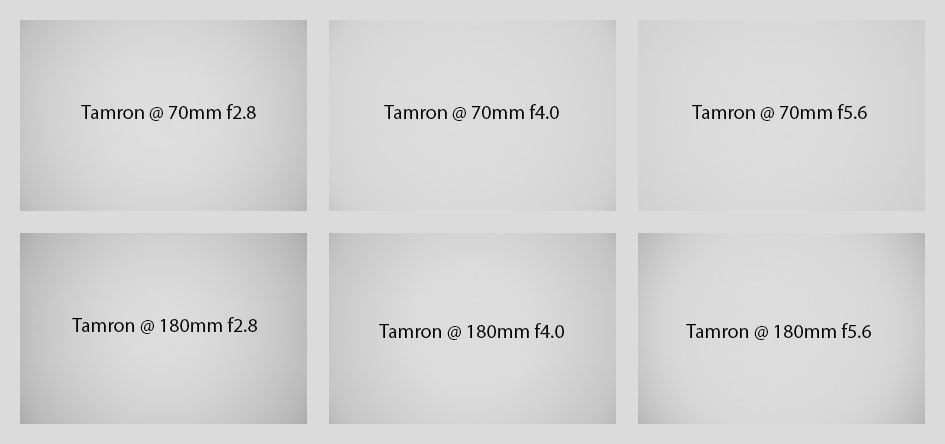
Above: Tamron 70-180mm f2.8 Di III at 70mm and 180mm focal length
The sample images above show that even with the lens profile applied vignetting is not completely eliminated. But on the wide end it’s pretty inconspicuous. With automatic shading compensation the extreme corners are lifted about 0.9 EV at 180mm f2.8. Adobe’s RAW converter automatically applies shading compensation as it was set in camera.
Distortions are of a light barrel type at 70mm focal length and turn to very noticeable pin-cushion at 180mm (see below). The setting for distortion compensation in camera is currently ignored by Adobe’s RAW converter and treated as OFF. So you have to manually activate Adobe’s lens profile for the new Tamron which became available with Lightroom 9.2.1 / CRAW 12.2.1. Just make sure when you activate the Adobe lens profile to reduce its vignetting compensation as this is added on top of the already applied shading compensation and leads to artificially bright corners. This is all pretty confusing and I can only hope that one day Adobe and the lens/camera makers can agree upon which part of the lens profile is automatically applied in RAW development and which part has to be activated manually in post-processing. But Adobe’s lens profile at least does a pretty good job to correct for distortions – as does the distortion compensation in camera when you shoot JPGs:
Distortions: Tamron 70-180mm f2.8 Di III at 70mm, as is (top) / with lens-profile (bottom)
Distortions: Tamron 70-180mm f2.8 Di III at 180mm, as is (top) / with lens-profile (bottom)
Rendering of point-light sources at night-shots
Night-shots pose a different challenge for lenses as the contrast is even higher than under bright sun and point-light sources can reveal some weaknesses such as coma, haloing and colour-aberrations that do not show up as prominently in other test-shots. The 100% crops below the main image show the effect of coma in the FF-corner of the new Tamron 70-180mm f2.8 Di III and the Sony FE 70-200mm f2.8 GM OSS at 70mm focal length and various apertures:
Above: Tamron 70-180mm f2.8 Di III at 70mm, f2.8; click image for 4k version, here for large original

Above: Tamron 70-180mm f2.8 Di III at 70mm; 100% crops from the FF-corner at f2.8 (left), f4.0 (middle), f5.6 (right)

Above: Sony FE 70-200mm f2.8 GM OSS at 70mm; 100% crops from the FF-corner at f2.8 (left), f4.0 (middle), f5.6 (right)
Both zoom lenses show very little coma at 70mm.
Rendering of out-of-focus point-light sources
This test is for the rendering of point-light sources in an out-of-focus background. The circle of confusion that is produced by this test is pretty indicative of Bokeh performance (in the background) and light fall-off. Ideally the out-of-focus image of the point-light is evenly lit and perfectly circular, with no “onion-rings”, and without coloration. Large aperture lenses normally produce an effect known as “cat’s eye” the further away from the optical axis the point-light is projected. This is due to optical vignetting in the lens barrel when light enters the lens from an angle.
All images were shot at the longest focal length and largest aperture. The new Tamron is first followed by the Sony FE 70-200mm f2.8 GM OSS. Crops are from the center, APS-C-corner, and FF-corner resized to make them comparable across all my reviews.
Above: Tamron 70-180mm f2.8 Di III at 180mm, f2.8
Above: Tamron 70-180mm f2.8 Di III at 180mm, f2.8; click image for 4k version, here for large original
Above: Sony FE 70-200mm f2.8 GM OSS at 200mm, f2.8; click image for 4k version, here for large original
The biggest visible difference between the lenses above is the smaller size of the Bokeh balls from the new Tamron but that was to be expected due to its smaller entrance pupil: With its shorter focal length of 180mm the Bokeh balls should be 10% smaller than from the Sony at 200mm. The effect is a bit overstated here as I could not exactly match magnification on both lenses for my test. Both lenses show mild onion rings with some additional grainy texture in the Bokeh balls of the new Tamron. Outlining is negligible on both lenses as is coloration. Looking towards the corners both lenses develop a very similar degree of cat’s eye effect – which is quite visible already at the APS-C-corner.
Now let’s see how this analysis of out-of-focus point-light sources translates into Bokeh-performance shooting a book-shelf. Crops are from the foreground, middle-ground, and background resized to make them comparable across all my reviews. I used the longest focal length that I could to produce a comparable shot to my other reviews which was in the case of the new Tamron 165mm while the Sony had to be zoomed in to 173mm to achieve the same magnification from the same distance:
Above: Tamron 70-180mm f2.8 Di III at 165mm, f2.8
Above: Tamron 70-180mm f2.8 Di III at 165mm, f2.8; click image for 4k version, here for large original
Above: Sony FE 70-200mm f2.8 GM OSS at 173mm, f2.8; click image for 4k version, here for large original
As was to be expected from the night shots both lenses have a very similar background Bokeh. Although to be fair the Sony could produce a better blur when used at 200mm focal length. In the foreground the Sony is slightly more nervous than the Tamron. The Tamron 70-180mm f2.8 Di III renders the transition zone (middle-ground) with a bit softer edges while the Sony FE 70-200mm f2.8 GM OSS seems to produce a bit stronger but harsher blur. The Sony also shows some greenish coloration from loCA in the middle-ground.
Close-up performance
The new Tamron goes down to a very good 1:1.8 magnification at 70mm focal length. The following images were shot at 1:1.8 magnification where the area of sharp focus is just 65 x 43mm. The crops shown below are from 0mm, 8mm, and 12mm off the center of the sensor respectively:

Above: Tamron 70-180mm f2.8 Di III at 70mm, f2.8; 100% crops

Above: Tamron 70-180mm f2.8 Di III at 70mm, f5.6; 100% crops

Above: Tamron 70-180mm f2.8 Di III at 70mm, f11; 100% crops
The Tamron 70-180mm f2.8 Di III produces OK results in the center when stopped down to f5.6 but stays mushy at the borders of the APS-C image-circle even when stopped down to f11. Field-curvature is not to blame for the dismal results outside the center as sharpness did not improve when the outer crops were specifically focused.
Using the lens at 180mm focal length produces much better results – albeit at lower magnification. The following images were shot at 1:4.3 magnification where the area of sharp focus is 155 x 103mm. The crops shown below are from 2mm, 10mm, and 17mm off the center of the sensor respectively:

Above: Tamron 70-180mm f2.8 Di III at 180mm, f2.8; 100% crops

Above: Tamron 70-180mm f2.8 Di III at 180mm, f4.0; 100% crops

Above: Tamron 70-180mm f2.8 Di III at 180mm, f5.6; 100% crops
Now results are very usable even at f2.8 and sharpness across a wide area of the frame is pretty good once the lens is stopped down to f5.6.
Flare, ghosting, and sun-stars
Catching a strong light-source shining directly into the lens is always a risky business: it could produce strange colorful ghost-images or reduce contrast considerably through flare and glare. The appearance of flare and ghosting depends on factors like the aperture and the angle of the light hitting the lens. So to judge the proclivity of the new Tamron 70-180mm f2.8 Di III for these artifacts I went through a series of well calculated shots against a strong light source to provoke glare and ghosting.
The new Tamron 70-180mm f2.8 Di III produces some ghosting artifacts at the short end and overall contrast is visibly reduced through veiling glare when the light source is within the APS-C image-circle. Contrast improves markedly when the light-source is closer to the FF-corner although it can produce a strong flare there:
Above: Flare and ghosting. Strong light hitting the Tamron 70-180mm f2.8 Di III at 70mm, f11; click image for 4k version or here for +3 EV exposure compensation
Above: Flare and ghosting. Strong light hitting the Tamron 70-180mm f2.8 Di III at 70mm, f11; click image for 4k version or here for +3 EV exposure compensation
The little bright square inset in the upper left of both images shows the respective area with an exposure compensation of +3 EV to make it easier to see which levels of black the lens renders at that point. What you can also see in the images above: The new Tamron 70-180mm f2.8 Di III does produce sunstars that are not very well defined even at f11.
When the light-source is just outside the corner there is an obvious streak/flare at 70mm focal length. Fortunately this only happens in a very small area around the corners:
Above: Flare and ghosting. Strong light hitting the Tamron 70-180mm f2.8 Di III at 70mm, f11; click image for 4k version or here for +3 EV exposure compensation
Next check out my sample images!
Check prices on the Tamron 70-180mm f2.8 Di III VXD at B&H, Adorama or WEX. Alternatively get yourself a copy of my In Camera book or treat me to a coffee! Thanks!





